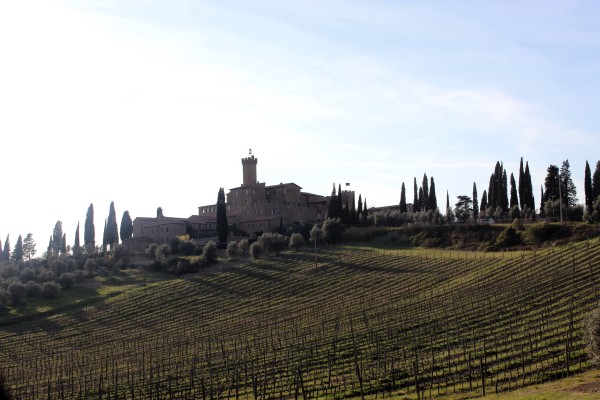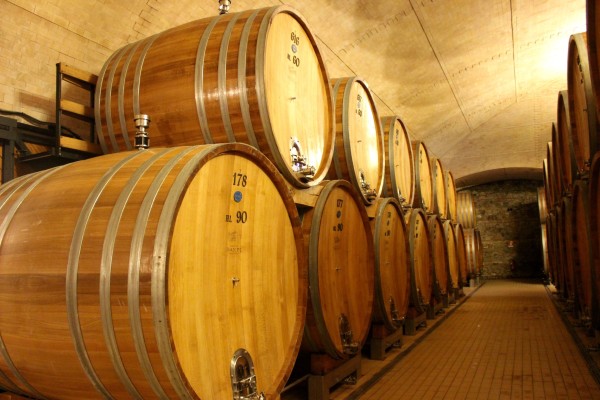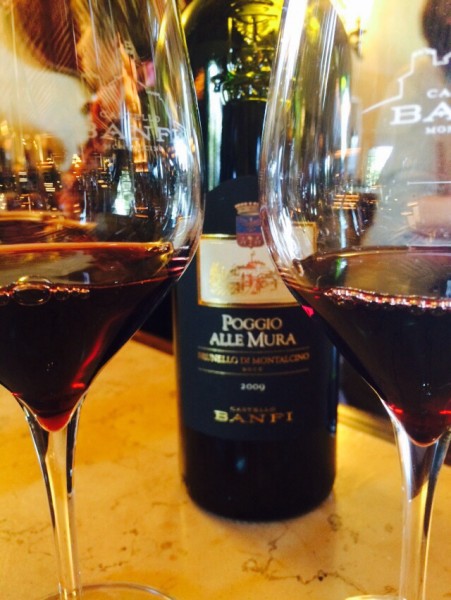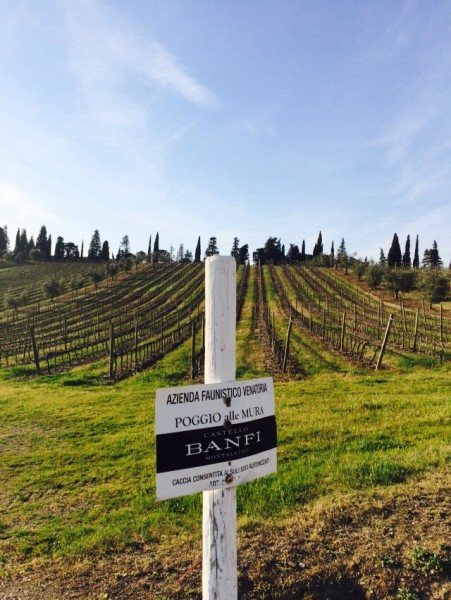 The Tuscan panorama is forever as we make our way on the strada.
The Tuscan panorama is forever as we make our way on the strada.
Here in Montalcino, vineyards, olive and fruit trees share the gentle verdant hills with medieval villages and castles.
On one perch, historic Castello Poggio alle Mura (meaning walled hilltop) graces the surrounding land that makes the Banfi estate.
Bernadette received us congenially with a taste of Rosso di Montalcino!
Serena Rossi, employed eleven years at Castello Banfi, begins our tour five minutes away at the production area. Started by the Mariani brothers from Lombardia, Banfi is an American company, originally importing Emilio-Romano Lambrusco to the U.S. in the sixties.
Growing since the seventies, the estate’s vineyards now comprise one-third of the 3,000 hectares (7,000 acres). Olive and plum trees abound, and forest covers a large part of the territory.
With so many vines, it seems surprising that the grapes are hand-picked. We sense dedication to tradition and respect for the harvest. For the best red wines, Brunello and Supertuscans, there is an added step of manual selection.
Banfi integrates a French oak body and stainless steel top and bottom to ensure temperature control in the fermentation tanks.
.
 We feel the vast cellar is a hallowed place. French oak barrels are made by the cooper, Gamba, of wood from central France. Every barrique is stamped with the forest of origin (Allier, Troncais, Nevers). Each yields 460 bottles of wine. Supertuscans and Poggio alle Mura Rossi and Brunelli age in these.
We feel the vast cellar is a hallowed place. French oak barrels are made by the cooper, Gamba, of wood from central France. Every barrique is stamped with the forest of origin (Allier, Troncais, Nevers). Each yields 460 bottles of wine. Supertuscans and Poggio alle Mura Rossi and Brunelli age in these.
Rosso is in oak for 8-10 months, and may be sold two years after harvest. The 2013 was just released.
Entering “La Catedral di Brunello,” we see large casks, which hold 16,000 bottles of wine. Their lifespan is thirty to thirty-five years. They are utilized for the Brunello DOCG, which ages two years in oak and may be sold in January, year five after harvest. The 2010 is released: a good vintage, Serena tells us.
Riserva ages three years and may sell year six.
After years of research here, one area has been dedicated to a specific Sangiovese clone for their select Poggio alle Mura wines.
 We return to the tasting room for the Brunello di Montalcino: dark ruby, intense, velvety.
We return to the tasting room for the Brunello di Montalcino: dark ruby, intense, velvety.
It is the Supertuscan, however, with estate-grown Sangiovese, Cabernet Sauvignon and Syrah that commands our attention and our palates today.
We purchase a bottle of SummuS Toscana IGT for its simple richness, and because of the palindrome moniker.
The winery currently produces 20% of the Brunello in the region.
From Etruscan roots, to the dreams of Giovanni Mariani, to tandem “pioneer technology” and research, Castello Banfi has emerged extraordinary.
Photos by James and Lisa Richardson.

